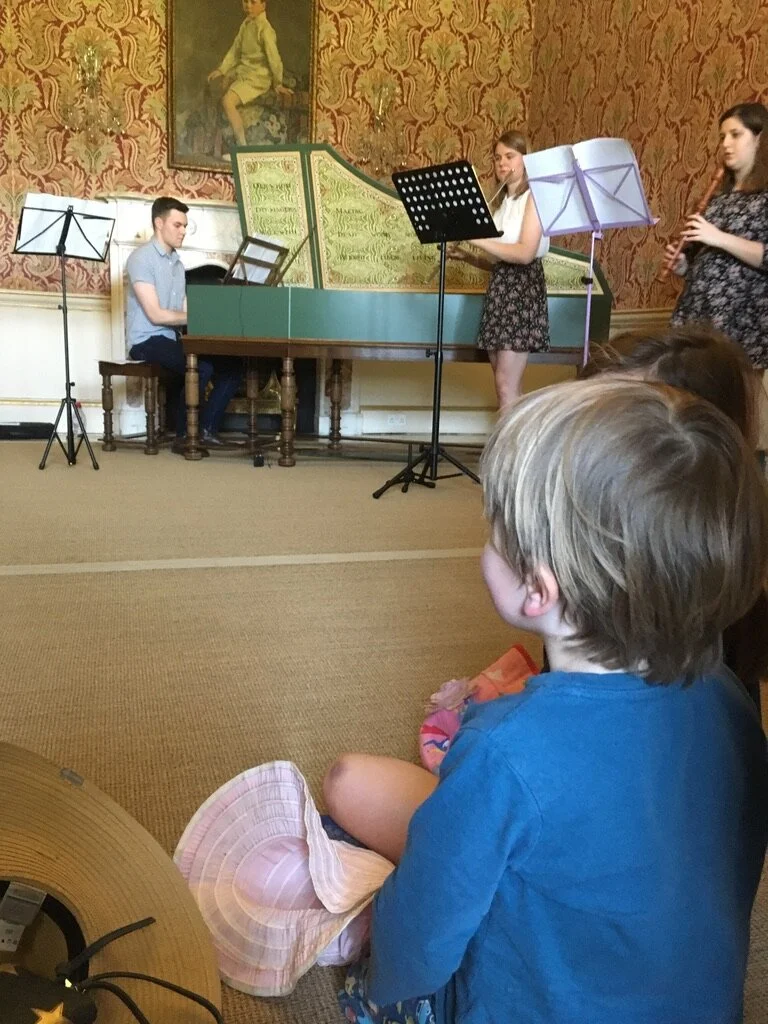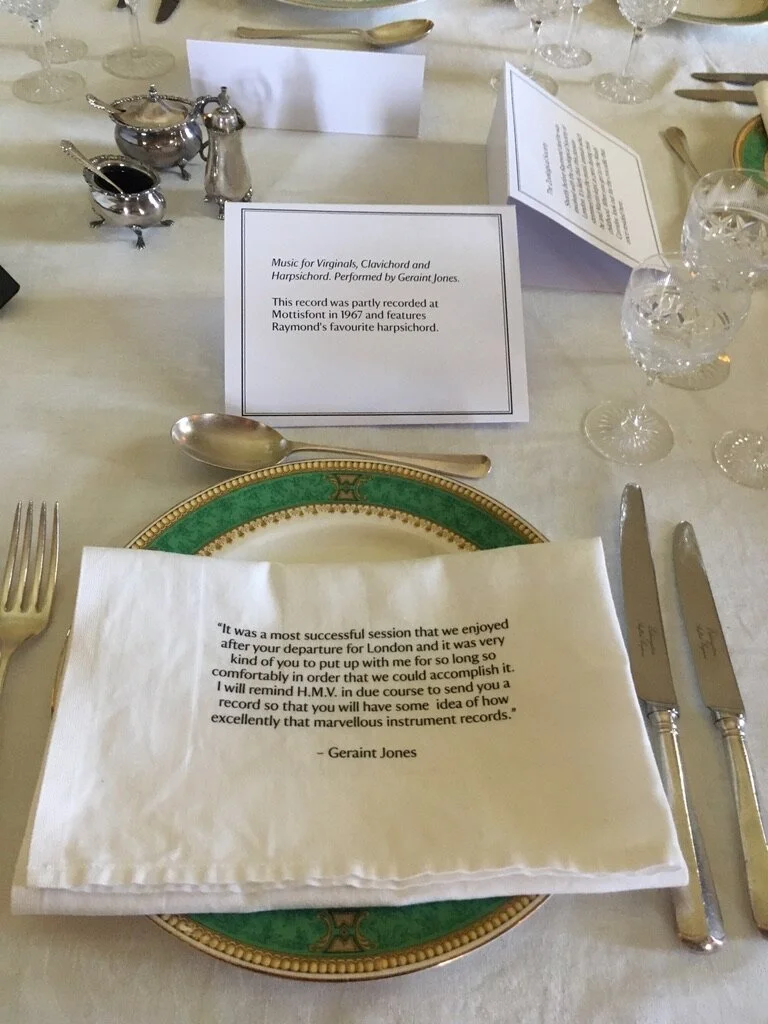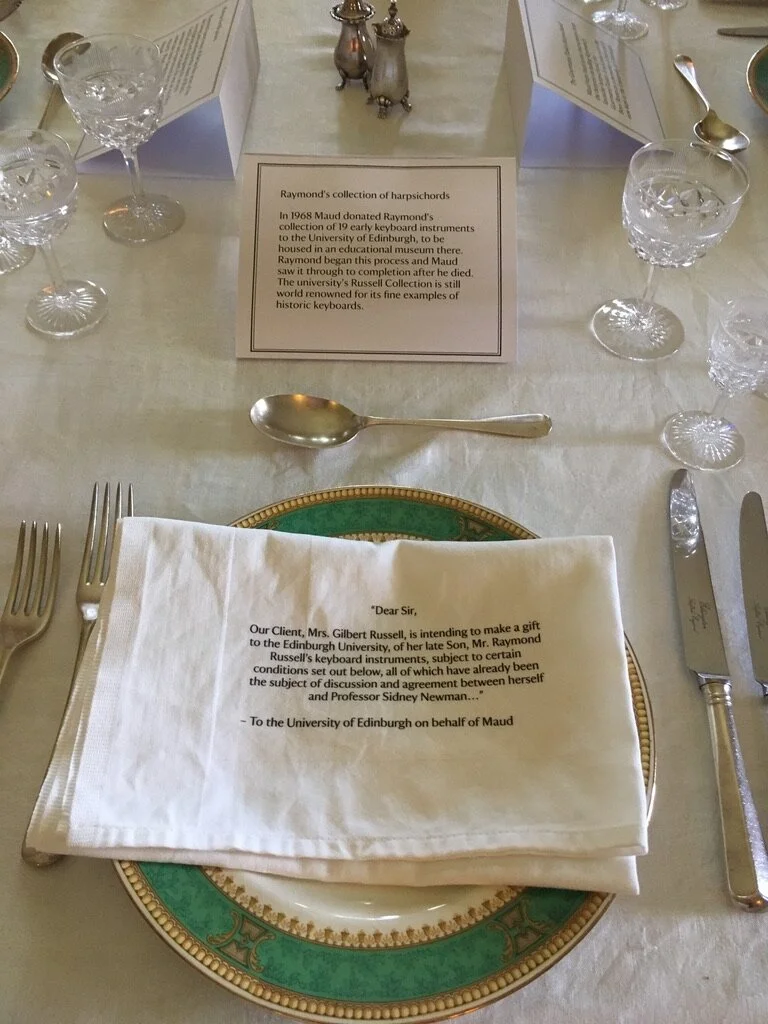
Interpretation Layer for Mottisfont Abbey
On entering the property visitors were taken on a journey through Raymond’s life, with each room reflecting a different stage.
In the Boy’s Room visitors were introduced to the young Raymond, his family, and some of his youthful pursuits.
Laid out for visitors to handle were copies of his letters from Eton, mock ups of family photo albums, piles of records and music and even his shooting & fishing diary (blank apart from documenting that he’d shot nothing and found his one attempt a “dull day”). The most significant object introduced to the room was a revival harpsichord, loaned by the University of Southampton. In 2016 the instrument was placed here to represent the connection between Raymond and harpsichords, and has been available for visitors to play ever since. Katharine’s research has since revealed that it is in the exact spot where Maud Russell kept one of Raymond’s favourite instruments, the Goermans/Taskin harpsichord, after his death.
*Front cover of a record made by Russell’s friend, Geraint Jones, at Mottisfont Abbey in 1967, by kind permission of Maud Russel
The Goermans/Taskin instrument (then known as a Couchet/Taskin) is pictured here in the Boys Room at Mottisfont Abbey, Hampshire.
The interpretation layer placed more importance on the instrument. A quote from Maud’s diary was used to highlight the Russell boys’ early introduction to harpsichords, indicating that they attended a concert given by Violet Gordon Woodhouse in 1934. The sound of the instrument was introduced to the room via a hidden speaker that emitted a recording of someone tuning the strings, something that Raymond did regularly when home.
The next room, The Study, focussed on Raymond’s experiences at Eton and Cambridge. A caricature of him taken from a Downing College publication, The Gryphon, and personal letters and family diary entries were displayed on Gilbert Russell’s desk.
In this room too, visitors were alerted to difficulties the Russell’s encountered negotiating Raymond’s troubled life. His attempts to run away from Eton were mentioned and a family reference book, left open on the chapter “The love that dare not speak its name”, was displayed.
It was in the White Room (Maud’s bedroom) where visitors could engage further with the troubles that confronted the family in the early 1940s, from Maud’s perspective.
These could be explored by taking in the objects on display and through reading Maud’s diary entries. The subjects covered were the death of Maud’s husband; Raymond’s status as a Conscientious Objector; his drug overdoses and eventual conscription to the army.
*Single manual harpsichord by Michael Johnson in the Red Room, Mottisfont Abbey.
Katharine’s research pinpointed The Red Room as the situ for two more of Raymond’s harpsichords, after his death.
It was in this room, therefore, that the harpsichord became the chief focal point with the addition of a beautiful instrument by the renowned harpsichord builder Michael Johnson.
Here Raymond’s career as a harpsichordist could be exhibited. Chairs were set out as if an audience might be about to appear, each with copies of original concert programmes from Raymond’s recitals. Music stands presented large publicity photos of Raymond sat at different instruments.
Multiple layers of interest were brought in with Johnson’s instrument. Johnson visited Mottisfont to see Raymond’s harpsicords in the early 1970’s; a visit which had a significant impact on his own influential instrument building business. Because of this connection, and his relative proximity, Johnson was happy to lend one of his instruments and make regular visits to tune and maintain it. This allowed National Trust visitors to hear live harpsichord sounds, take a closer look at the inner workings of a harpsichord and provided opportunities to ask an expert about the instruments.
*Jane Chapman coaching a University of Southampton student in a live musical event in the Red Room.
Importantly, the availability of a high quality, well-maintained harpsichord enabled live musical events.
These attracted further attention to Raymond and harpsichords, and returned the sounds of the instrument and live music to Mottisfont.
On leaving the Red Room, visitors would pass through a small Ante Room which was turned into a Cabinet of Curiosities representing Raymond’s collecting career.
Bell jars were filled with examples of items that Raymond had collected in his lifetime including Maltese coins, surgical instruments and, of course, pictures of his harpsichords. A copy of his book The Harpsichord and Clavichord: An Introductory Study was also displayed.
The final room dedicated to Raymond’s narrative was the Dining Room. This was presented as an homage to Raymond life and his mother’s efforts to ensure his work was remembered.
A radio and headset, placed on a sideboard, gave visitors the opportunity to listen to Raymond’s opinions on 20th century harpsichord building, through a reproduction of a BBC Third Programme broadcast he gave.
The table was set for dinner with each place setting representing a different friend or relative of Raymond’s. In the centre of the table, propped up against a jar of lilies, were two Times obituaries written after Raymond’s untimely death in 1964.
Snippets of conversations about completing the posthumous donation of Raymond’s keyboard collection to the University of Edinburgh were printed on napkins, placed in their relevant person’s plate.
Feedback from National Trust staff and visitors was very positive. Many had expected an exhibition based on a harpsichord collector to be dry and uninteresting, but found themselves drawn in by the details of Raymond’s colourful, short life. The multiple musical events attracted visitors of all ages to new sounds, instruments, and the possibility of a musical heritage associated with an historic property.













